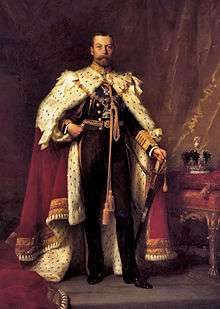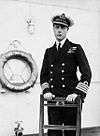Monarchy of South Africa
| Monarchy of South Africa | |
|---|---|
|
| |
|
| |
| Details | |
| Style |
His Majesty 1910–1952 Her Majesty 1952–1961 |
| First monarch | King George V |
| Last monarch | Queen Elizabeth II |
| Formation | 31 May 1910 |
| Abolition | 31 May 1961 |
| Residence |
Buckingham Palace Government House |
| Appointer | Hereditary |
The monarchy of South Africa was the system of government in which a hereditary monarch was the sovereign of the Union of South Africa from 1910 to 1961. South Africa shared the Sovereign with the United Kingdom, other Dominions, and latterly other Commonwealth realms. The monarch's constitutional roles were mostly delegated to the Governor-General of the Union of South Africa. The royal succession was the same as the succession to the British throne.
The monarchy was abolished on 31 May 1961, when South Africa became a republic and left the Commonwealth. On 1 June 1994 South Africa rejoined the Commonwealth as a republic, after the end of Apartheid.
History
The monarchy was created by the South Africa Act 1909 which united four British colonies in southern Africa: Cape of Good Hope, Natal, Orange River Colony and Transvaal. The Act also made provisions for admitting Southern Rhodesia as a fifth province of the Union in the future, but Southern Rhodesian voters rejected this option in a referendum held in 1922. South-West Africa became a League of Nations mandate of the Union in 1915. Following a referendum on the subject, South Africa adopted a new constitution in 1961 which abolished the monarchy.
List of monarchs
| House of Windsor | |||||||
| Portrait | Name | Birth | Death | Monarch from | Monarch until | Consort | Heir |
|---|---|---|---|---|---|---|---|
 |
King George V | 3 June 1865 | 20 January 1936 | 31 May 1910 | 20 January 1936 | Queen Mary | Son: Edward, Prince of Wales |
 |
King Edward VIII | 23 June 1894 | 28 May 1972 | 20 January 1936 | 10 December 1936[1] (Abdicated) |
None | Brother: Prince Albert, Duke of York |
 |
King George VI | 14 December 1895 | 6 February 1952 | 10 December 1936 | 6 February 1952 | Queen Elizabeth | Daughter: Princess Elizabeth (Duchess of Edinburgh from 1947) |
 |
Queen Elizabeth II | 21 April 1926 | 6 February 1952 | 31 May 1961 | Prince Philip, Duke of Edinburgh | Son: Charles, Prince of Wales | |
| Titles |
|---|
| George V 31 May 1910 – 13 May 1927 By the Grace of God, of the United Kingdom of Great Britain and Ireland and of the British Dominions beyond the Seas King, Defender of the Faith, Emperor of India 13 May 1927 – 20 January 1936 His Majesty George V, by the Grace of God, of Great Britain, Ireland and of the British Dominions beyond the Seas King, Defender of the Faith, Emperor of India |
| Edward VIII 20 January 1936 – 10 December 1936 By the Grace of God, of Great Britain, Ireland and of the British Dominions beyond the Seas King, Defender of the Faith, Emperor of India |
| George VI 10 December 1936 – 22 June 1948 By the Grace of God, of Great Britain, Ireland and of the British Dominions beyond the Seas King, Defender of the Faith, Emperor of India 22 June 1948 – 6 February 1952 By the Grace of God, of Great Britain, Ireland and of the British Dominions beyond the Seas King, Defender of the Faith |
| Elizabeth II 6 February 1952 – 29 May 1953 By the Grace of God, of Great Britain, Ireland and of the British Dominions beyond the Seas Queen, Defender of the Faith 29 May 1953 – 31 May 1961 By the Grace of God, Queen of South Africa and of Her other Realms and Territories, Head of the Commonwealth |
Visits
King George VI, his wife Queen Elizabeth, and their daughters Elizabeth and Margaret, visited South Africa in 1947. Queen Elizabeth II and the Duke of Edinburgh visited South Africa, after it became a republic, in 1995 and 1999.
See also
References
- ↑ His Majesty King Edward the Eighth's Abdication Act, 1937 (Act No. 2 of 1937)
| ||||||||||||||
.svg.png)
